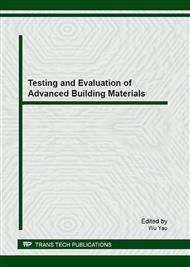p.184
p.189
p.195
p.200
p.205
p.211
p.215
p.220
p.225
The Influence of Curing Temperature on the Coordination of the Expansion and Strength of High Strength Expansive Concrete
Abstract:
The influence of curing temperature on the relationship between the expansion and the strength was studied. The results showed that under the standard curing condition (20。C), the expansion and strength of the high strength expansive concrete develop unisonously with the prolongation of age. However, under the high curing temperature, there is a conflict between the expansion and strength of the concrete. Elevated curing temperature (40。C) promotes the hydration of expensive agent and cement. However the quickly developing strength of the concrete limits its expansion, and leads to the lowest restricted expansion rate of the concrete at 40。C. But suitable expansion made the microstructure of the concrete denser, which resulted in the highest strength of the concrete at 40。C. High curing temperature (60。C) leads to excessive expansion at early hydration age. Appropriate volume expansion is benefit to the improvement of pore structure of hardened paste by reducing large pores and to increase the strength of the concrete. However, excessive volume expansion is harmful to the microstructure and leads to the lowest strength of the concrete at 60。C.
Info:
Periodical:
Pages:
205-210
Citation:
Online since:
January 2013
Authors:
Keywords:
Price:
Сopyright:
© 2013 Trans Tech Publications Ltd. All Rights Reserved
Share:
Citation:


